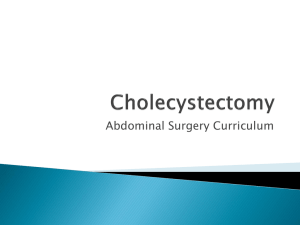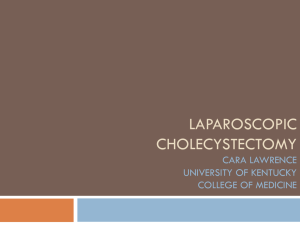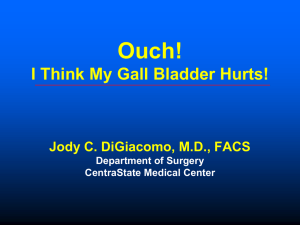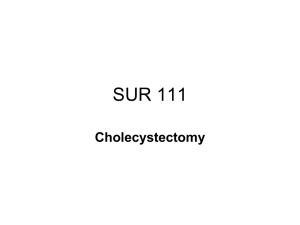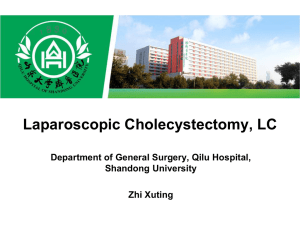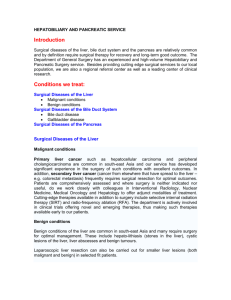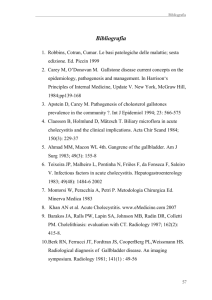Technical Challenges of Laparoscopic Cholecystectomy in Patients
advertisement
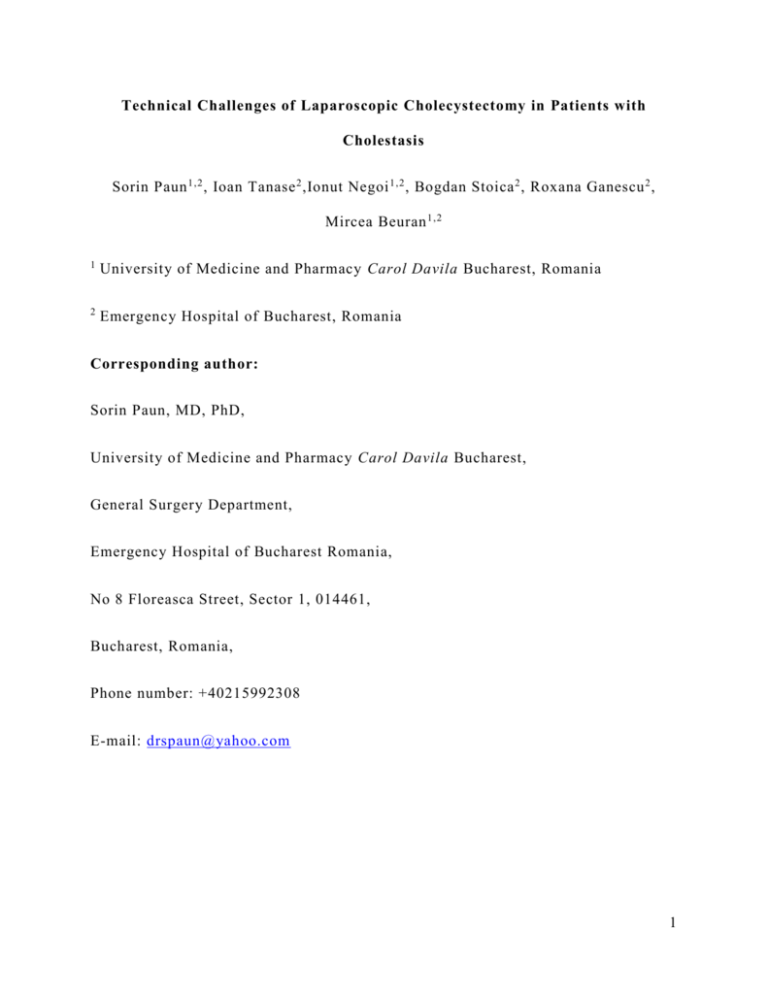
Technical Challenges of Laparoscopic Cholecystectomy in Patients with Cholestasis Sorin Paun 1,2 , Ioan Tanase 2 ,Ionut Negoi 1,2 , Bogdan Stoica 2 , Roxana Ganescu 2 , Mircea Beuran 1,2 1 University of Medicine and Pharmacy Carol Davila Bucharest, Romania 2 Emergency Hospital of Bucharest, Romania Corresponding author: Sorin Paun, MD, PhD, University of Medicine and Pharmacy Carol Davila Bucharest, General Surgery Department, Emergency Hospital of Bucharest Romania, No 8 Floreasca Street, Sector 1, 014461, Bucharest, Romania, Phone number: +40215992308 E-mail: drspaun@yahoo.com 1 Abstract Objective: The purpose of this study is to summarize the current knowledge regarding cholecystectomy in patients with cholestasis. Method: Systematic review of the literature up to March 2015, using electronic search of the PubMed/Medline, Web of Science, and Science Direct, databases using as MeSH term or truncated words „cholecistectomy”, „laparoscopy”, „common bile duct stones”. Results: The treatment of common bile duct stones (CBD) includes pre or postoperative endoscopic retrograde cholangiopancreatography (ERCP), surgical exploration (open or laparoscopic) of the CBD or intraoperative cholangiography (IOC). Currently the therapy of the patients with cholecystitis and CBD lithiasis is still a subject of controversy. Cholestasis is a proedisposing factor for intraoperative bleeding difficult dissection. Conclusion: Laparoscopic cholecystectomy in patients with cholestatic disease i s feasible only for an experienced laparoscopic surgeon. Gallbladder dissection should be performed close to the cholecyst wall and CBD stones should be surgically removed or by endoscopic approach. Intraoperative bleeding is the most frequent difficulty for such surgeries. Key words: difficult laparoscopic cholecystectomy, colecystitis, choledocolithiasis, cholestasis. 2 Introduction Although mainly asymptomatic, patients with biliary gallstones frequently associate common bile duct (CBD) stones. A percent ranging between 10-18% (1,2) from the patients that underwent cholecystectomy for gallbladder stones associate CBD lithiasis. The presence of CBD stones can be anticipated in the presence of jaundice, cholangitis, pancreatits, with altered hepatic function, or directly identified by imagistics (3). The percentage of preoperative undiagnosed CBD reaches almost 25% even for the newest imagistics (4). Acute cholecystitis is the most common infectious complication of gallstones, occuring with a frequency of 6 11% for the patients with 7-11 years of symptomatic gallstones (5). Recent studies are showing indirect signs of CBD stones in 37.7% of patients with acute cholecystitis, these signs being noticed for 72 % of patients with prooved choledocholithiasis (6). Changes in liver morphology was seen in 66% of patients with gallstones and cholecystitis (7), the most important alteration being non -specific reactive hepatitis and hepatic steatosis. More important changes were noticed for patients with CBD obstruction or cholangitis were associated more strongly with CBD stones (8); cholestasis has been found for 28% of the patients with CBD stones (7). Moreover, jaundice and pain in the right upper quadrant were associated in all cases with altered liver pathology (7). Ishizaki et al., have found post ERCP status to be a significant predictor of difficulty in adhesiolysis and Calot's triangle dissection (9). 3 Method: Systematic review of the literature up to March 2015, was performed using electronic search of the PubMed/Medline, Web of Science, and Science Direct, databases using as MeSH term or truncated words „cholec ystectomy”, „laparoscopy”, „common bile duct stones”. Bibliografy of the retrieved articles has been used for secondary searches. Treatment alternatives The treatment of common bile duct stones includes pre or postoperative endoscopic retrograde cholangiopancreatography (ERCP), surgical exploration (open or laparoscopic) of CBD or intraoperative cholangiography (IOC). In the era of Open Cholecystectomy, intraoperative exploration of CBD had better results than ERCP (10). At the beginning of minimally invasive surgery, laparoscopic exploration of extrahepatic bile ducts was not technically feasible, cleaning biliary tree being afterwards more often performed using ERCP (11) and subsequently through laparoscopic surgery (12) at first by transcystic approach and then with the advanced laparoscopic technique of choledocotomy (13,14). Currently the therapy of the patients who cholecystitis to CBD lithia sis is still a subject of controversy (14-16). Although there are no differences in terms of morbidity and mortality between laparoscopic exploration of CBD and perioperative ERCP(15) Endoscopic Retrograde CholangioPancreatography followed by laparoscopic cholecystectomy is the preferred method. In the presence of complications such as biliary pancreatitis with jaundice or c holangitis, the gold standard for removing choledocolithiasis is ERCP with sphincterotomy (18 -19), 4 some studies reporting a higher frequency remnant choledocolithiasis after postoperative ERCP (17). The intraoperative cholangiography procedure (catheterisation of the CBD, followed by dye injection), can improve visualization of the biliary tree anatomy. While the combination of LC + IOC is frequently used in medical centers worldwide, the precise benefits for patiens remains to be established (16). Nevertheless in the era of Magnetic Resonance CholangioPancreatography (MRCP), IOC indications have decreased but are not yet considered obsolete, but rather a valuable tool for evaluation of biliary tree anatomy, bile duct injury, or suspected choledocholithiasis (17). In terms of benefits to patients, efficacy and safety, IOC addition to the routine LC treatment of symptomatic cholelithiasis does not improve rates of remnant CBD stones or bile duct injury but lengthens the operative time (16). Procedures timing Regarding the time interval between procedures, clearence of both CBD and gallbladder stones is recommended during the same hospitalisation (12), the proper time of surgery being within 5 days from onset of symptoms (20) moreover laparoscopic cholecystectomy, Laparoscopic cholecystectomy after more than 16 weeks from the endoscopic sphincterotomy associated a 10 times risk of bile duct injury (BDI) (19). Latest trends in surgical attitude indicate as feasable the sameday ERCP and cholecystectomy with an overall 2 days decrease of hospitalization (20). 5 Surgical technique Inspection Pericolecistic inflammatory process that can extend from the gallbladder to the great omentum, right flexure of the colon, duodenum and visceral surface of the liver can cause difficulties from the begining of surgery in order to identify the gallbladder and to expose the subhepatic space. Gallbladder exposure and adhesiolisis Liver disease increases the difficulty of the surgery, especially in the presence of cirrhosis, and liver failure. Jaundice and hepatic cholestasis, hepatic diseases predispose to bleeding and difficult dissection. Moreover, excessive bleeding during adhesiolisis, due to local inflammation associated with hypocoagulability caused by hyperbilirubinemia, can flood the operative field. Electrodissection and electrocoagulation should be avoided beca use of the risk of thermal injuries, especially when local anatomy is altered. Exposing the visceral surface of the liver in patients with inflammatory process is a key step of the intervention, the pericholecystic inflamatory mass and adhesions representing the leading cause for conversion to open cholecystectomy (21). After the exposure of the gallbladder fundus, the surgeon can choose puncture followed by aspiration of its content, especially in patients with important gallbladder distension allowing a better traction and exposure, taking in consideration the subsequent the parietal swelling and thickening, factors that make difficult the gallbladder handling. 6 Infundibulum exposure Difficulty can be encountered in gallbladder grasping especially in patients with contracted or disteded, gallbladder, with the tendency to slip away. Presence of inflammation around the gall bladder makes the wall fr agile and oedematous, with problems for grasping (22–24). Starting dissection in the most accessible point and achieving good orientation is the key of a successful difficult cholecystectomy (25) – it will be not forgotten the golden rule of dissection very close to the gallbladder wall. In the case of impacted gallstones that can alter infundibular grasping, a cholecystendesis can be used to empty the gallblader (2-3 cm above the infundibular-cystic region), but with the risk of intense bleeding from the parietal transsection, and bile contamination of the peritoneal cavity. Specialized toothed graspers with long and wide mouth can facilitate a good traction (23). Dissection of the Calot triangle If possible, dissection is usually started at the gallbladder’s neck for a propper exposure of the Calot triangle, if not the surgeon should approach dissection as close as possible to the gallbladder infundibulum, in the area where the anatomical landmarks are clearly visualized. In the onset of hepatic pediculitis with altered local anatomy, and a dark operating field (due to the presence of blood absorbing most of the light), carefull blunt dissection with proper element ident ification is mandatory. 7 If anatomy is unclear, the recomandations are to keep the dissection plane tight close to the gallblader wall. Kelly et al. noticed that anterograde approach in cases with severe inflamation can reduce the conversion rate from 5,2% to 1,2% (26). Bleeding from Calot’s vascular arcade is usually mild and self limited and can be controlled by pad compression, followed by permanent haemostasis (usually clip or ligature) (27). Cystic artery and duct management During this step of the dissection the surgeon could benefi t from intemitent lavage and suction along with blunt dissection to mentain a clear operative field. Bleeding in thist time of the dissection occurs either from cystic or right hepatic artery. The bleeding is sometimes diffuse and a pad can help if continous pressure is applied for enough time. Most often di ffuse bleeding stops due to spasm of the small vessels. If bleeding continues, another efficent method is to clean the blood clots with the suction device, and, once the vessel is visible , the surgeon should grasp the bleeding vessel with the left hand grasper (27). Once the cystic artery sealed, after proper identification, the bleeding is usually reduced. For the cystic duct seal the surgeon should be ready with large clips, hence it is common for patients with CBD stones to have a larger cystic. In patients with a wide and short cystic duct, or in cases where clips cannot be used, intracorporeal knots or EndoGIA stapler can be used to seal the cystic duct. As a general rule, it is recommended a good visualisation with both clip ends exposure when applied. 8 Dissection of the gallbladder from the liver bed Once both cystic artery and duct were succesfully sealed and cut, the surgeon should proceed to remove the gallbladder from the liver bed. In the setting of a cholestatic liver with high bilirubinemia and high bleeding risk, the key of the dissection is represented by avoiding lessions to the hepatic bed. T his can be achieved with a firm but gentle traction with the left grasper and keeping the dissection close to the gallbladder wall. Perforating the cholecyst usually restarts the bleeding at the puncture site, followed by bile and stones spillage in the peritoneal cavity. Bile must be carefully suction ed followed by lavage of the subhepatic space, also stones must be totally removed before being lost in the peritoneal cavity. Some authors found Surgicel (oxydized cellulose polymer) to be the most effective in controlling bleeding from the liver bed. If not available, for 5 minutes can stop the difuse bleeding (27). If propper dissection in the liver bed cannot be achieved, a partial cholecystectomy might be an option, leaving the superior gallbladder wall attached to the liver and cauterising the mucosal surface (28). Gallbladder extraction An endobag should always be used for extracting the gallbladder and it’s content from the abdominal cavity avoiding contamination and spillage in the peritonea l cavity. Complications Besides morbidity and mortality associated with laparoscopic procedure alone any invasive manuvers for exploring and cleaning the CBD increase the total risk for the 9 patient. In the setting of cholestasis , the overall morbidity and mortality risk is further increased but it’s nevertheless strongly connected to the surgeon’s experience. These „difficult” laparoscopic cholecystectomies should be atte mpted only after the surgeon passed the learning curve. Common bile duct injuries not only increase morbidity but can also be fatal, even if recognized intraoperatory, sometimes with redo surgeries (often with unsatisfactory results ). Conclusion: Laparoscopic cholecystectomy in patients with cholestatic disease is feasible only for an experienced laparoscopic surgeon. Gallbladder dissection should be performed close to the cholecyst wall and CBD stones should be surgically removed or by endoscopic approach. Intraoperative bleeding is the most frequent difficulty for such surgeries. Acknowledgement: This paper is supported by the Sectoral Operational Programme Human Resources Development (SOP HTD), financed from the European Social Fund and by the Romanian Government under the contract number POSDRU/159/1.5/S/137390. – for dr. Ioan Tanase and dr. Bogdan Stoica. 10 Bibliography 1. H. M. Soltan, L. Kow, and J. Toouli, “A simple scoring system for predicting bile duct stones in patients with cholelithiasis.,” J. Gastrointest. Surg., vol. 5, no. 4, pp. 434–7, Jan. . 2. K. S. Gurusamy, V. Giljaca, Y. Takwoingi, D. Higgie, G. Poropat, D. Štimac, and B. R. Davidson, “Endoscopic retrograde cholangiopancreatography versus intraoperative cholangiography for diagnosis of common bile duct stones.,” Cochrane database Syst. Rev., vol. 2, p. CD010339, Feb. 2015. 3. J. L. Sherman, E. W. Shi, N. E. Ranasinghe, M. T. Sivasankaran, J. G. Prigoff, and C. M. Divino, “Validation and improvement of a proposed scoring system to detect retained common bile duct stones in gallstone pancreatitis.,” Surgery, Feb. 2015. 4. B. Millat, A. Fingerhut, A. Deleuze, H. Briandet, E. Marrel, C. de Seguin, and P. Soulier, “Prospective evaluation in 121 consecutive unselected patients undergoing laparoscopic treatment of choledocholithiasis.,” Br. J. Surg., vol. 82, no. 9, pp. 1266–9, Sep. 1995. 5. G. D. Friedman, “Natural history of asymptomatic and symptomatic gallstones.,” Am. J. Surg., vol. 165, no. 4, pp. 399–404, Apr. 1993. 6. B. A. Becker, E. Chin, E. Mervis, C. L. Anderson, M. H. Oshita, and J. C. Fox, “Emergency biliary sonography: utility of common bile duct measurement in the diagnosis of cholecystitis and choledocholithiasis.,” J. Emerg. Med., vol. 46, no. 1, pp. 54–60, Jan. 2014. 7. J. M. Geraghty and R. D. Goldin, “Liver changes associated with cholecystitis.,” J. Clin. Pathol., vol. 47, no. 5, pp. 457–60, May 1994. 8. V. J. Desmet, “Histopathology of cholestasis.,” Verh. Dtsch. Ges. Pathol., vol. 79, pp. 233–40, Jan. 1995. 9. Y. Ishizaki, K. Miwa, J. Yoshimoto, H. Sugo, and S. Kawasaki, “Conversion of elective laparoscopic to open cholecystectomy between 1993 and 2004.,” Br. J. Surg., vol. 93, no. 8, pp. 987–91, Aug. 2006. 10. D. R. Fletcher, “Changes in the practice of biliary surgery and ERCP during the introduction of laparoscopic cholecystectomy to Australia: their possible significance.,” Aust. N. Z. J. Surg., vol. 64, no. 2, pp. 75–80, Feb. 1994. 11. “Gallstones and laparoscopic cholecystectomy. NIH Consensus Development Panel on Gallstones and Laparoscopic Cholecystectomy.,” Surg. Endosc., vol. 7, no. 3, pp. 271–9, Jan. . 11 12. A. Cuschieri, E. Lezoche, M. Morino, E. Croce, A. Lacy, J. Toouli, A. Faggioni, V. M. Ribeiro, J. Jakimowicz, J. Visa, and G. B. Hanna, “E.A.E.S. multicenter prospective randomized trial comparing two-stage vs single-stage management of patients with gallstone disease and ductal calculi.,” Surg. Endosc., vol. 13, no. 10, pp. 952–7, Oct. 1999. 13. I. J. Martin, I. S. Bailey, M. Rhodes, N. O’Rourke, L. Nathanson, and G. Fielding, “Towards T-tube free laparoscopic bile duct exploration: a methodologic evolution during 300 consecutive procedures.,” Ann. Surg., vol. 228, no. 1, pp. 29–34, Jul. 1998. 14. G. Decker, F. Borie, B. Millat, J. C. Berthou, A. Deleuze, F. Drouard, F. Guillon, J. G. Rodier, and A. Fingerhut, “One hundred laparoscopic choledochotomies with primary closure of the common bile duct.,” Surg. Endosc., vol. 17, no. 1, pp. 12–8, Jan. 2003. 15. B. V. M. Dasari, C. J. Tan, K. S. Gurusamy, D. J. Martin, G. Kirk, L. McKie, T. Diamond, and M. A. Taylor, “Surgical versus endoscopic treatment of bile duct stones.,” Cochrane database Syst. Rev., vol. 12, p. CD003327, Jan. 2013. 16. D. Guo-Qian, C. Wang, and Q. Ming-Fang, “Is intraoperative cholangiography necessary during laparoscopic cholecystectomy for cholelithiasis?,” World J Gastroenterol, vol. 21, no. 7, pp. 2147–2151, 2015. 17. K. R. Sirinek and W. H. Schwesinger, “Has Intraoperative Cholangiography during Laparoscopic Cholecystectomy Become Obsolete in the Era of Preoperative Endoscopic Retrograde and Magnetic Resonance Cholangiopancreatography?,” J. Am. Coll. Surg., Jan. 2015. 18. A. Croo, E. De Wolf, K. Boterbergh, A. Vanlander, H. Peeters, R. I. Troisi, and F. Berrevoet, “Laparoscopic cholecystectomy in acute cholecystitis: support for an early interval surgery.,” Acta Gastroenterol. Belg., vol. 77, no. 3, pp. 306–11, Sep. 2014. 19. A. M. Beliaev and M. Booth, “Late two-stage laparoscopic cholecystectomy is associated with an increased risk of major bile duct injury.,” ANZ J. Surg., Jan. 2015. 20. J. L. Wild, M. J. Younus, D. Torres, K. Widom, D. Leonard, J. Dove, M. Hunsinger, J. Blansfield, D. L. Diehl, W. Strodel, and M. M. Shabahang, “Same-day combined endoscopic retrograde cholangiopancreatography and cholecystectomy: Achievable and minimizes costs.,” J. Trauma Acute Care Surg., vol. 78, no. 3, pp. 503–9, Mar. 2015. 21. J. A. Teixeira, C. Ribeiro, L. M. Moreira, F. de Sousa, A. Pinho, L. Graça, and J. C. Maia, “[Laparoscopic cholecystectomy and open cholecystectomy in acute cholecystitis: critical analysis of 520 cases].,” Acta Med. Port., vol. 27, no. 6, pp. 685–91, Jan. . 22. M. A. K. M. Vivek, A. J. Augustine, and R. Rao, “A comprehensive predictive scoring method for difficult laparoscopic cholecystectomy.,” J. Minim. Access Surg., vol. 10, no. 2, pp. 62–7, Apr. 2014. 12 23. P. Lal, P. N. Agarwal, V. K. Malik, and A. L. Chakravarti, “A difficult laparoscopic cholecystectomy that requires conversion to open procedure can be predicted by preoperative ultrasonography.,” JSLS, vol. 6, no. 1, pp. 59–63, Jan. . 24. S. Kuldip and O. Ashish, “Difficult laparoscopic cholecystectomy: A large series from north India,” Indian J Surg, vol. 68, no. 205, p. 68, 2006. 25. A. Ota, N. Kano, H. Kusanagi, S. Yamada, and A. Garg, “Techniques for difficult cases of laparoscopic cholecystectomy.,” J. Hepatobiliary. Pancreat. Surg., vol. 10, no. 2, pp. 172–5, Jan. 2003. 26. M. D. Kelly, “Laparoscopic retrograde (fundus first) cholecystectomy.,” BMC Surg., vol. 9, no. 1, p. 19, Jan. 2009. 27. C. Mushtaq, A. Shahnawaz, W. Ab Hamid, L. Asim, Y. Umar, S. B. Faud, and I. Sikender, Laparoscopic Management of Difficult Cholecystectomy. 2012. 28. G. Beldi and A. Glättli, “Laparoscopic subtotal cholecystectomy for severe cholecystitis.,” Surg. Endosc., vol. 17, no. 9, pp. 1437–9, Sep. 2003. 13
